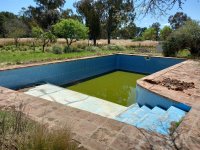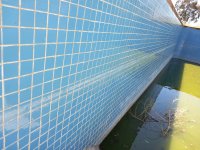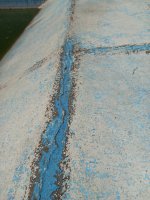There's a pool in the old house we're renovating. It's about 45 years old, hasn't been used for 7 or 8 years. It loses water, but we're not sure from where. As you can see in this picture, in the shallow end around the steps, there's a crack that someone in the past attempted to repair. There's also a crack in the tiles on the far end of the shallow part, but higher. Those cracks don't extend to the deeper part of the pool. There's also some cracking on the floor of the shallow end, that also appear to have been patched at some point.
I live in a very remote area of South America. There is one trustworthy contractor here, but I don't think he has much pool experience. He suggests basically building a new pool inside this one, with concrete and rebar, and shoring up one side wall by digging it out and adding another one of concrete. He's very good with concrete, so that's his solution to many things. I'd like to avoid that expense. I'm thinking about pulling out the tiles where there are cracks and filling in with concrete, then covering with liquid pool membrane. And just covering the cracks in the floor with that as well.
I don't mind if I have to redo this every season, as long as it costs me less than about 15% of the big job.
Any advice?
I live in a very remote area of South America. There is one trustworthy contractor here, but I don't think he has much pool experience. He suggests basically building a new pool inside this one, with concrete and rebar, and shoring up one side wall by digging it out and adding another one of concrete. He's very good with concrete, so that's his solution to many things. I'd like to avoid that expense. I'm thinking about pulling out the tiles where there are cracks and filling in with concrete, then covering with liquid pool membrane. And just covering the cracks in the floor with that as well.
I don't mind if I have to redo this every season, as long as it costs me less than about 15% of the big job.
Any advice?






 One thing for sure, there is a leak down low at that current waterline. Maybe even the main drain if there is one installed. If there is a leak behind some of the tiles near the bottom, pulling them away from the gunite shell may be the only way to confirm. It would be good if you could pump-out that green water to inspect for a drain if installed and inspect it. I suppose one option would be to remove some of the lower tiles at a certain height, fill in any cracks in the gunite shell to prevent further leaking, then simply apply a plaster coating of your choosing for cosmetic purposes. Another option, however it may not be ideal in your remote area, would be to have a vinyl liner made for that shape of pool and just use it that way. But let's give others time to review your situation to get more ideas. Thanks for posting.
One thing for sure, there is a leak down low at that current waterline. Maybe even the main drain if there is one installed. If there is a leak behind some of the tiles near the bottom, pulling them away from the gunite shell may be the only way to confirm. It would be good if you could pump-out that green water to inspect for a drain if installed and inspect it. I suppose one option would be to remove some of the lower tiles at a certain height, fill in any cracks in the gunite shell to prevent further leaking, then simply apply a plaster coating of your choosing for cosmetic purposes. Another option, however it may not be ideal in your remote area, would be to have a vinyl liner made for that shape of pool and just use it that way. But let's give others time to review your situation to get more ideas. Thanks for posting.